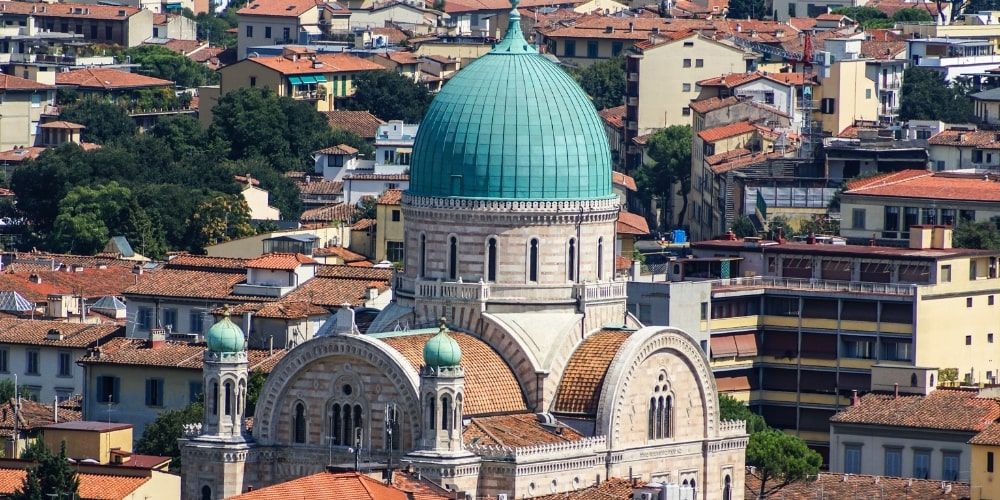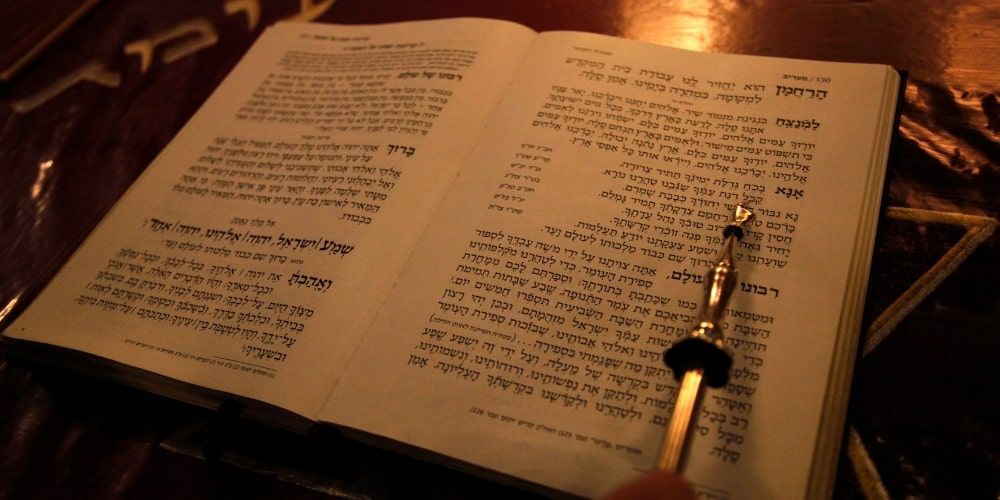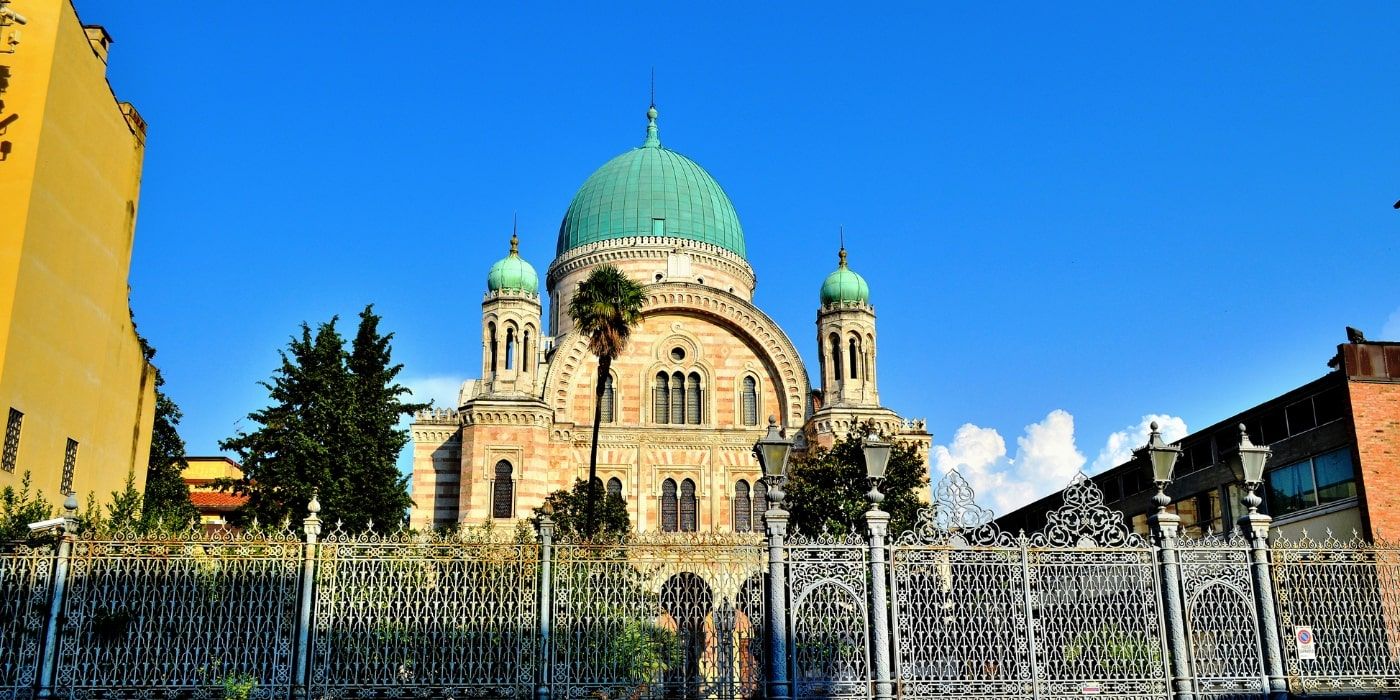Would you like to contemplate Synagogue and Jewish Museum of Florence and take an exciting journey looking for the roots and secrets of this fascinating thousand-year-old culture? The evocative Jewish district, nestled in this city, the cradle of the Italian Renaissance, offers many points of interest to travelers who seek an alternative to classic tourist destinations, like the enchanting Synagogue and Jewish Museum of Florence. Are you looking for some useful advice about what to do in Florence in seven days? Strolling through the streets of the historical centre near the elegant Piazza d'Azeglio, dotted with fine 19th-century buildings, you will be mesmerized by a feeling of awe and wonder at the sight of the majestic and marvelous green dome of the Synagogue of Florence, standing beautifully against the backdrop of the city.
This amazing place of worship, an indispensable stronghold for the faithful of Tuscan Judaism, is perfectly integrated into the multifaceted local history and enchants you with its extraordinary and monumental beauty, which characterises both its interiors and its interiors. The Synagogue and Jewish Museum of Florence is one of the most emblematic examples of the combination of stylistic features of Venetian art, such as mosaics, Moorish, Arab, Byzantine, and Romanesque art, thanks to the refined colours and the preciousness of the materials chosen for its realisation. By getting the Florence Pass, you can benefit from exclusive advantages reserved for its holders, such as amazing discounts and priority entrance to the city's most charming museums.
Discover Florence Pass
Admire the Synagogue and Jewish Museum of Florence: the exciting history of the fascinaning temple

The first traces of the Florentine Jewish community date back to the 12th century, although the most remarkable records come down to us date back between the 15th and 16th centuries. Its settlement took place over the centuries and faced various vicissitudes due to the oppression it suffered throughout its history: the fact that the areas allocated to it were often outside the city walls suggests this. Initially, its settlement rose around the famous Ponte Vecchio (Old Bridge). In 1571, the Duke of Florence and Grand Duke of Tuscany Cosimo I De Medici commissioned the architect Bernardo Buontalenti to reorganize the urban layout.
In the 16th century, they established a ghetto within the quadrilateral at Piazza della Repubblica, Via dei Pecori, Via Roma, and Via Brunelleschi; following the unification of Italy, however, the Jews were able to achieve complete emancipation and took advantage of more protection. The site chosen to erect the new Jewish Temple in Florence was in the district known as the Mattonaia. Following the bequest of Cav. David Levi, the process for its construction began in 1868.
Synagogue Florence Italy: the exterior, Interior, and works of art
Among the most enchanting things to do in Florence, we recommend a visit to the Synagogue and Jewish Museum of Florence, a wonderful place of worship, which features harmonious characteristics and it's distinguished by its exotic Moorish style, which is eclectic and colorful. The soft lighting filtering through the stained glass windows enhances this beauty. The synagogue's façade is marked by a tripartite structure and walnut portals, adorned with the skillful use of pink pomade and white travertine. The frontal entrances are graced by arches and refined Moorish decorations, while a magnificent green dome, once gilded and made of copper, crowns the structure.
Upon entering, visitors find themselves in the worship hall, a treasure trove of masterpieces. This hall has a square plan and features adjoining aisles. The eye is drawn to the elegant arabesques illuminated with gold leaf and geometric designs, created by Giovanni Panti, which embellish the walls. In the background, one can see the Aron ha-Kodesh, adorned with exquisite mosaics from the Venetian school, housing the Sèfer Torah, the scrolls of the Pentateuch. Looking up at the dome, you will notice the single-lancet windows and an opening that illuminates the interior. The podium, benches, pulpit, and bronze lamps were designed and crafted by skilled Florentine artisans as part of a unified creative project.
Guide to the Jewish Museum of Florence
Visiting the adjacent Jewish Museum, located inside the magnificent Synagogue, will allow you to delve into the history of Florence's Jewish community and learn about its rituals and ancestral religious traditions through an engaging experiential narrative. Walking through the spaces of the exhibition gallery, you can consult the materials illustrating the historical events, supported by valuable documentation and pictures, precious textiles, ornaments, and symbolic objects, which are fundamental to the practice of worship.
Accessing the second floor, you can immerse oneself in the everyday life of the devotees thanks to ceremonial exhibits and furnishings related to the celebration of religious festivities. Before concluding your visit, we recommend you add the room dedicated to commemorating the Holocaust to your itinerary.
The Synagogue and Jewish Museum of Florence: opening hours, tickets, and guided tours

To visit the Synagogue and Jewish Museum of Florence there are a lot of alternatives to choose from, and you can also purchase tickets online. If you wish to explore the Synagogue of Florence and the engaging Jewish Museum attached, it is preferable to book in advance to avoid spending long hours in line. The cost of the standard ticket is €9, while the reduced ticket rate is €5 and it applies to minors aged between 6 and 14, students aged between 15 and 26, journalists admitted to practice, and people who hold a ticket for the Synagogue and the Jewish Museum of Siena, subject to proof of ownership through a document.
Some categories are exempt from payment, such as children between 0 and 6 years of age, disabled persons and their carers, Florence Card holders, and group carers. If you prefer to take advantage of the reservation fee, €1 is added to the standard price.
During the summer period, from June 1st to September 30th, visiting hours are as follows: from 10:00 a.m. to 6:30 p.m. from Sunday to Thursday and from 10:00 a.m. to 5:00 p.m. on Friday. Between 1st October and 31 May, opening hours are from 10:00 a.m. to 5:30 p.m. from Sunday to Thursday and from 10:00 a.m. to 3:00 p.m. on Friday.
Due to religious precepts, you have to pay attention to the fact that on Shabbat and Jewish holidays, entry to the synagogue and museum is prohibited to visitors.
How to get to the Synagogue and Jewish Museum in Florence
Discovering the Synagogue and Jewish Museum of Florence is an unmissable experience for anyone looking forward to diving into the city's rich cultural heritage. Would you like to know how to reach the Synagogue and Jewish Museum of Florence? You can arrive at the splendid religious building by choosing the efficient public transport service. The bus lines that pass by the Colonna01 stop are 6, 14, 23, and 31.
If you prefer traveling by car to take advantage of greater freedom and autonomy, you will find the S. Ambrogio car park located in Piazza L. Ghiberti.
You can explore Florence and its beautiful sights by undertaking an exciting hop-on hop-off tour with the exclusive tour buses.
Discover Hop-on Hop-off Bus Tours by City Sightseeing FlorenceWhat do you have to do to enter the synagogue Florence Italy?
Visitors must follow specific rules and precautions regarding clothing and behavior to enter the Synagogue of Florence according to religious guidelines. The entrance is controlled by metal detectors, allowing one visitor at a time. Guests are required to deposit borders and any objects in the lockers provided. Additionally, it is essential to prefer clothing in keeping with the sacredness of the place, covering shoulders and legs up to the knee with shawls, sarongs, or long trousers. Men must wear headgear, which is why you can find kippots available at the entrance of the temple.
FAQ section and curiosities
How old is the synagogue Florence Italy?
In 1870, its design began, which was inspired by the climate of greater freedom, fundamental in influencing the long search for Jewish identity from an architectural and artistic point of view, and entrusted to the talented architects Marco Treves, Falcini, and Micheli. The foundation stone of the monumental complex of the synagogue and Jewish Museum of florence came from Jerusalem, a holy city of great importance for Judaism, Christianity, and Islam, and the inauguration took place in 1882.
Where is the oldest Jewish synagogue in the world?
Artefacts from the oldest Jewish sinagogue in the world, dating from between 150 and 128 BC, have been discovered on the sacred island of Delos. The synagogue of El Ghriba, located on the island of Djerba in Erriadh, Tunisia, dates back to 584 BC and is the oldest on the African continent.
What is the green dome in Florence?
It is one of the most iconic and identifying symbols of Florence's evocative Jewish district, standing out elegantly and majestic, with its vivid hue, among the red terracotta roofs of the surrounding buildings.
What is the largest synagogue in Europe?
The largest place of worship in Europe for believers of Judaism is the synagogue of Budapest, located in Dohány Street, whose construction dates back to the 1850s.
How many Jews live in Florence today?
The Jewish community in Florence, consisting of approximately 1,000 members, is one of the oldest and most remarkable in Italy. Most Florentine Jews belong to the Sephardic ethnic-cultural stock or are of Italian descent.
What is the oldest synagogue in Italy?
According to excavations and archaeological discoveries, the oldest synagogue in Italy is the one in Ostia Antica, dating from the 1st century AD, which stood along the ancient stretch of the Via Severiana. The second oldest religious building in the Hellenistic-Roman style rises in Bova Marina.
About the author
Written on 15/04/2025




Simone Pini
Do you dream of contemplating ancient Synagogue and Jewish Museum of Florence? Follow Visit Italy's advice to admire their wonderful masterpieces.